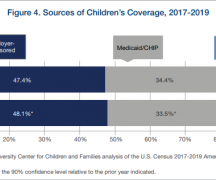BY SUSAN TEBBEN
The Ohio Department of Education is still watching the impact from the COVID-19 pandemic affect the children of the state.
Interim Superintendent of Public Instruction Stephanie Siddens had to deliver some grim realities last month to a Senate Primary and Secondary Education Committee eager to learn about what the next steps will be for school districts.
“Across the country, there is a real and urgent need to embrace new and innovative ways to accelerate learning,” Siddens said.
Siddens said expected decreases happened in enrollment and state test scores between the 2019-2020 and 2020-2021 school years, with participation in state tests reduced in areas with “vulnerable” students.
“While the data are not, certainly, the kind of news we want to share, we know they’re not all-together surprising given the circumstances,” Siddens said.
As expected by state officials, total enrollment for pre-K through 12th grades was down 3%, equivalent to 53,000 students. Almost half of those 53,000 were pre-school and kindergarten-aged students.
The early-education decreases were the result of delayed enrollment by parents and other educational alternatives chosen during the pandemic, according to Siddens.
The number of students being home-schooled increased as well, up 25% between the 19-20 and 20-21 school year.
Of more concern to Siddens and the ODE is the rise in “chronically absent” students.
“Almost 1,000 schools had more than 30% of their students chronically absent,” Siddens said.
Statewide, one in four students were chronically absent, but that number is “likely conservative,” according to the superintendent, because school districts had flexibility in reporting attendance as they tried to maintain hybrid and remote learning. Still, the data the state has shows a 7% increase in the state, or about 109,000 students.
The state defines chronic absenteeism as missing 10% or more of the school year for any reason, excused or unexcused, and on the ODE website, it acknowledges that absenteeism is more chronic in “historically underserved” areas, often urban districts.
Because the state has had an influx of COVID-19-related aid, $6.5 billion of which has been distributed for educational needs, Siddens said the ODE plans to and has encouraged individual districts to use money from the American Rescue Plan and the Elementary and Secondary School Emergency Relief (ESSER) Fund, both federal funding sources, to target chronic absenteeism. One of the main goals of the education-related ARPA and ESSER funds was to combat learning loss related to the COVID-19 pandemic.
The higher rate of chronic absenteeism compounds with expected dips in proficiency, shown through state testing. English and Language Arts proficiency rates decreased 8% across most grades and math proficiency decreased by 13% statewide, according to state data.
“Ohio has had substantial achievement gaps before the pandemic and the gaps were further exacerbated by the events of the past two years,” Siddens said.
Under ARPA regulations, school districts have to keep at least 20% of their funds specifically to address learning loss with methods such as extended school, summer enrichment programs and before/after school programs.
The state can’t tell districts how to spend their money, it merely acts as a “pass-through” for the funds, according to Siddens, but it did release guidance on what can and can’t be done with the funding.
While the state tests are giving the state somewhat of an idea where the school districts stand in terms of overall proficiency, officials say diagnostic reports that come from individual districts have shown a better picture of what’s going on at ground level. The diagnostic reports are not required to be provided to the state, but Dr. Christopher Woolard, interim chief programming officer for the ODE, said they’ve heard “lots of good examples” of the practice taking place in districts.
“The state tests are giving information on that annual check-in from that state perspective, but the real power of that data is the data that’s being generated on a regular daily, weekly, monthly, quarterly basis at the local level,” Woolard said.
The same could be said of the state’s look at the new Fair School Funding plan, to be implemented as part of the most recent state operating budget, passed this year.
Siddens said the state has been working to implement significant changes to the funding formula for Ohio’s education system, including the direct funding of schools, how the state creates a more equitable method of funding, plus establishing a base cost based on the cost to educate students and minimum staffing levels at individual districts.
The state expects to bring changes forward in January, having updated the schools in early December of the plans.
Some of those changes have to come in the form of direct dialogue with districts in order to know what is needed in different areas. ODE director of the Office of Budget and School Funding, Aaron Rausch, said it’s particularly important to work with the state’s educational service centers, in furtherance of that goal.
“We’ve asked them to work locally with districts to identify, regionally, here’s what the need is, understanding that the need in northwest Ohio might be different than what the need is here in central Ohio,” Rausch said.
As it attempts to work through the many changes headed for Ohio education, the ODE is also working on leadership changes in their own department.
Siddens, who was the senior executive for the state’s Center for Student Supports, was named as interim superintendent after previous superintendent Paolo DeMaria left the post, and after his chosen replacement, former Deputy State Superintendent John Richard, left after less than a month for a new job.
A job search for a permanent superintendent has begun anew, with plans for a search firm to begin the process in January. The Ohio Board of Education has the final say on the new hire, and they’ve had leadership transition of their own, with President Laura Kohler stepping down in October after controversy reigned over a racism resolution the board approved, then repealed.
After Kohler’s departure. Charlotte McGuire was named to the presidential post, with fellow board member Steve Dackin named as vice president.
***
Also from Ohio Capital Journal:
Record number of Americans sign up for ACA health insurance
A record 13.6 million Americans have signed up for health coverage for 2022 on the Affordable Care Act marketplaces, the Biden administration announced last month.
President Joe Biden’s top health advisers credited the increased government subsidies, which lowered out-of-pocket costs, for the surge in enrollment. They also said enhanced personal assistance and outreach helped connect more people to health insurance plans.
Some of the largest increases are in Florida, Texas, Georgia and nine other states that have not expanded Medicaid under the Affordable Care Act.
The previous marketplace enrollment record was 12.7 million in 2016, the final year of President Barack Obama’s administration. Enrollment largely stagnated under President Donald Trump, who cut tens of millions of dollars in funding for navigators, who help people sign up for coverage.
Open enrollment for the marketplace began Nov. 1 and ends Jan. 15. READ MORE
Election lies get standing ovation at Jim Jordan Q&A
A crowd rose to its feet in applause at a forum last month when a man questioned GOP Congressman Jim Jordan about what he would do about the untrue assertion that the 2020 presidential election was stolen from Donald Trump.
Jordan was speaking at a December event hosted by the Lima Community for Medical Freedom and took questions from the crowd afterward. A man who did not share his name and identified himself as a tradesman and a Jordan voter said he wanted to ask about the “elephant in the room” that he hears about everyday “that no politician wants to talk about.”
Jordan, in his speech, had said restrictive voting laws passed in Georgia last year and similar efforts in other states would alleviate the threat of election fraud in 2024. The man in the crowd said the issue couldn’t wait.
“Everybody I talk to is not satisfied with 2024,” he said. “Everyone I talk to thinks our election was stolen.”
The crowd started to clap and rise in applause toward Jordan, who watched with a smile. He nodded along as the man said he and others saw “a couple of weeks’ worth of evidence” of fraud in swing states, according to footage of the event posted on social media.
“My understanding: If someone gets caught robbing a bank, they don’t get to keep the money, and if somebody stole the election, they should not be able to keep it,” the man said to the congressman.
There’s no evidence of widespread election fraud. Rare, isolated incidents occur, but an Associated Press review of every potential case of voter fraud in six battleground states disputed by Trump amounted to fewer than 475, far short of enough mass to tip an election. Numerous audits haven’t detected any widespread fraud, and Trump’s own attorney general and election security director have said there’s no reason to believe the election was stolen. READ MORE






